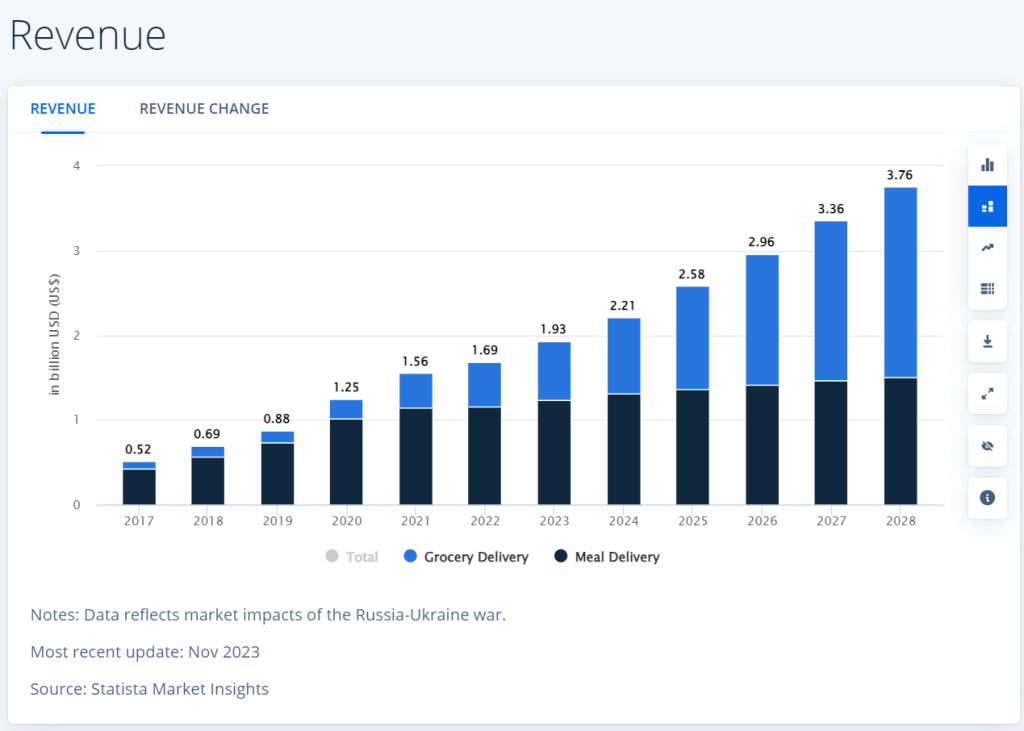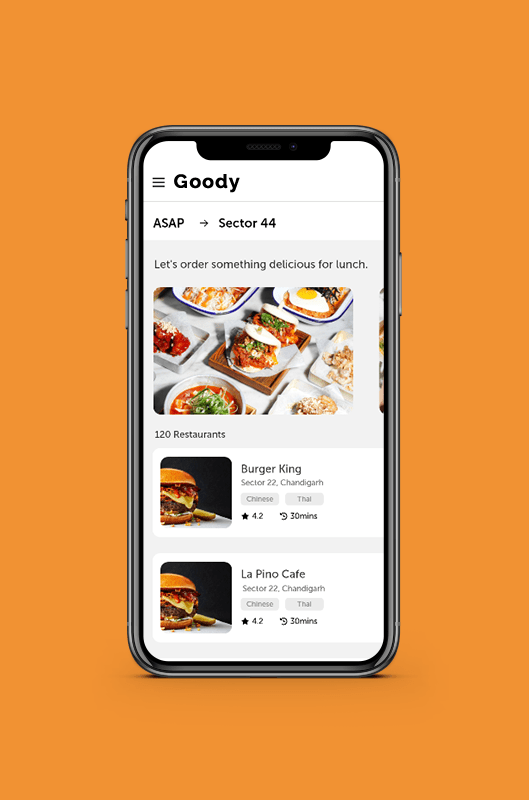In the rapidly evolving landscape of business opportunities, entrepreneurs are constantly seeking innovative avenues to establish lucrative ventures. Among these, on-demand food delivery applications stand out as a promising domain for entrepreneurs in the UAE.
Technology is changing very fast, and entrepreneurs are currently looking for different ways to gain a market position that will help them generate high revenues.
These platforms enable seamless connections between grocery stores and users, allowing customers to order goods according to their preferences and have them delivered directly to their door with remarkable ease and convenience.
In this blog, we will go over the complexities of developing a delivery app in the UAE. Exploring prices, critical features, and the development process will provide entrepreneurs with invaluable insights into creating a successful enterprise.
Delivery App Market Stats In UAE
The Online Food and Grocery Delivery markets in the United Arab Emirates are poised for substantial growth, with projections indicating significant revenue increases and expanding consumer demand for convenience and safety. Here are stats indicating why it is good time to invest in developing a delivery app:

- The market is expected to increase at a compound annual growth rate (CAGR) of 14.21% between 2024 and 2028, with a projected market value of US$3.76 billion by 2028.
- The Grocery Delivery market in the UAE is predicted to develop at a rate of 34.8% by 2025.
- The Grocery Delivery market in the United Arab Emirates is expected to be worth roughly US$1.31 billion by 2024.
- The convenience and safety that online meal delivery services bring to consumers have led to an increase in demand in the UAE.
Must Have Features In A Delivery App
UAE food apps need seamless communication with customers, restaurants, and delivery partners, offering convenience, reliability, and satisfaction to all stakeholders. Here are must have features
1. Streamlined Ordering Process
Food delivery apps should prioritize an efficient and user-friendly ordering system to cater to hungry customers’ needs promptly. Frustration with complicated ordering processes can drive users to seek alternatives.
2. Flexible Payment Options
Offering diverse payment methods, including cash, electronic payments, and reward-based transactions, enhances customer convenience and satisfaction. Incorporating promotional offers and discounts can incentivize preferred payment methods.
3. Seamless Registration Experience
A smooth and uncomplicated sign-up procedure is essential for a positive user experience. Simplifying the initial registration process and requesting additional details only when necessary streamlines user navigation and encourages engagement.
4. Pickup Feature Integration
Providing additional functionalities like a pickup option from restaurants enhances the app’s competitiveness. Allowing customers to pre-order and minimize wait times upon arrival adds value and convenience to the service.
5. Accurate Information Provision
Addressing uncertainties inherent in online delivery, such as tracking the delivery person’s location, is crucial. Ensuring customers receive comprehensive details regarding their orders, including preparation status and estimated delivery times, fosters transparency and trust.
6. 24/7 Customer Support
Offering real-time customer assistance enables prompt resolution of inquiries and issues, minimizing customer dissatisfaction. Accessible support channels enhance user satisfaction by addressing concerns effectively and promptly.
Revenue Models For A Delivery App
Explore diverse revenue streams is essential for the success of grocery, food or any delivery app. From commission-based models to data monetization, discover the various strategies shaping the landscape of this booming industry.
1. Commission-Based Model
The delivery app charges a commission fee from the restaurants or stores for each successful order placed through the platform. This fee is typically a percentage of the order value.
2. Subscription Model
Users pay a recurring subscription fee to access premium features such as faster delivery times, exclusive discounts, or priority customer support.
3. Delivery Fee Model
Users are charged a flat delivery fee for each order they place through the app, regardless of the order value or distance traveled. This fee can vary based on factors like distance, time of day, or demand.
4. Advertisement Model
The app generates revenue by displaying advertisements from local businesses to users. These advertisements can be targeted based on the user’s location, order history, or preferences.
5. White-Label Solution
The app offers a white-label solution where businesses can license the platform to create their own branded delivery app. Revenue is generated through licensing fees, setup costs, and ongoing maintenance charges.
6. Data Monetization
The app collects valuable data on user preferences, ordering habits, and location data. This data can be anonymized and sold to third-party companies for market research, targeted advertising, or to improve their own services.
Top Delivery Apps In UAE Right Now
Discover the top delivery apps revolutionizing dining experiences in the UAE! From Talabat’s diverse cuisines to Uber Eats’ seamless service, explore the convenience and variety these apps offer.
1. Talabat
Talabat is one of the leading food delivery apps in the UAE, offering a wide range of cuisines from local eateries to popular international chains. With its user-friendly interface and efficient delivery service, Talabat has gained a strong foothold in the market, providing customers with convenient options for ordering food online.
2. Deliveroo
Deliveroo is another popular delivery app in the UAE, known for its curated selection of restaurants and quick delivery times. It partners with a variety of restaurants, ranging from upscale dining establishments to casual eateries, catering to diverse tastes and preferences. Deliveroo’s seamless ordering process and reliable service make it a go-to choice for many residents and visitors in the UAE.
3. Uber Eats
As an extension of the popular ride-sharing service Uber, Uber Eats has quickly become a favorite among UAE residents for food delivery. Leveraging Uber’s technology and logistics infrastructure, Uber Eats offers a convenient and reliable platform for ordering food from a diverse range of restaurants. With its efficient delivery network and user-friendly interface, Uber Eats provides customers with a seamless dining experience from the comfort of their homes.
4. Zomato
Zomato offers a comprehensive platform for food delivery, restaurant discovery, and reviews in the UAE. In addition to its delivery services, Zomato provides users with valuable insights into restaurants’ menus, ratings, and customer feedback, helping them make informed decisions when ordering food. With its extensive network of partner restaurants and user-friendly app interface, Zomato continues to be a prominent player in the food delivery industry in the UAE.
5. Careem
Careem, known primarily as a ride-hailing app, has expanded its services to include food delivery in the UAE. With its extensive network of drivers and efficient logistics system, Careem offers a reliable platform for ordering food from various restaurants. The app’s integration with Careem’s existing services provides users with a seamless experience, allowing them to easily switch between ride-hailing and food delivery based on their needs.
How To Develop A Delivery Mobile App In UAE?
Developing a delivery mobile app involves creating a user-friendly platform for seamless ordering and efficient delivery services. This guide outlines key steps and considerations for building an effective app.
1. Market Research and Analysis
Identify your target market and understand their delivery needs. This involves conducting thorough research to identify the demographics, preferences, and pain points of your potential users. Understanding their specific delivery needs will help tailor your app to meet those requirements effectively.
2. Define Your Unique Selling Proposition (USP)
Determine what sets your delivery app apart from existing ones. Your USP should clearly articulate the unique value proposition that your app offers to users. This could be innovative features, faster delivery times, better customer service, or a unique delivery model that differentiates your app from competitors.
3. Business Model Development
Choose a revenue model (commission per delivery, subscription, advertising, etc.). Selecting the right revenue model is essential for the sustainability and profitability of your delivery app. This could involve charging a commission on each delivery, offering subscription-based services, or generating revenue through advertising partnerships.
4 .Technology Stack Selection
Choose the appropriate tech stack based on your app’s requirements (frontend, backend, database, etc.). Selecting the right technology stack is essential for building a scalable, secure, and efficient delivery app. This involves choosing the right programming languages, frameworks, libraries, and databases based on your app’s specific requirements.
5. UI/UX Design
Design an intuitive and user-friendly interface for both customers and delivery personnel. User experience design plays a critical role in the success of your delivery app. Focus on creating an intuitive and seamless user interface that makes it easy for customers to place orders and for delivery personnel to manage deliveries efficiently.
6. Development
Develop the app in iterations, starting with a minimum viable product (MVP) to gather user feedback. Adopting an iterative development approach allows you to launch a basic version of your app quickly and gather feedback from users to iterate and improve upon it over time. This agile development methodology helps ensure that your app meets user expectations and evolves based on user feedback.
7. Partner Onboarding
Recruit and onboard delivery partners (drivers, couriers) based on your business model. Building a reliable network of delivery partners is essential for the success of your delivery app. Develop a robust onboarding process to recruit and train delivery partners, ensuring they understand the app’s features, delivery procedures, and service standards.
8. Testing and Quality Assurance
Conduct thorough testing across various devices and platforms to ensure app functionality and performance. Quality assurance is crucial for ensuring that your delivery app functions reliably across different devices, operating systems, and network conditions. Perform comprehensive testing, including functional testing, compatibility testing, performance testing, and security testing, to identify and address any issues or bugs before launch.
9. Launch and Marketing
Plan a marketing strategy to attract both customers and delivery partners. A well-defined marketing strategy is essential for generating awareness and attracting users and delivery partners to your app. This could include digital marketing tactics such as social media marketing, search engine optimization (SEO), content marketing, email marketing, and influencer partnerships.
10. Partnership and Integration
Explore partnerships with other businesses (restaurants, retailers) to expand delivery options. Partnering with restaurants, grocery stores, retailers, and other businesses can expand the range of delivery options available on your app, providing users with a wider selection of products and services to choose from.
How Much Does It Cost To Develop A Delivery App In UAE?
Developing a delivery app in the UAE involves several factors that contribute to its overall cost. Here are factors that can influence the cost of developing such an app:
1. App Features and Complexity
The complexity and features of the delivery app significantly impact development costs. Basic features like user registration, order tracking, payment integration, and push notifications are standard. However, additional features such as real-time tracking, route optimization, multiple payment options, and customer support functionalities will increase the development costs.
| Features | Estimated Cost Range |
| Basic features | $5,000 – $10,000 |
| Additional features | $10,000 – $20,000 |
2. Platform
The choice of platforms (iOS, Android, or both) affects development costs. Developing for both platforms generally costs more than focusing on a single platform initially. Additionally, if you opt for cross-platform development using frameworks like React Native or Flutter, it might affect costs differently compared to native development.
| Platform | Estimated Cost Range |
| iOS platform development | $8,000 – $15,000 |
| Android platform development | $8,000 – $15,000 |
| Cross-platform development | $15,000 – $25,000 |
3. UI/UX Design
A well-designed user interface (UI) and user experience (UX) are crucial for the success of a delivery app. Investing in a visually appealing and intuitive design can enhance user engagement and satisfaction but may also incur higher design costs.
| Design Complexity | Estimated Cost Range |
| Basic UI/UX design | $3,000 – $8,000 |
| Advanced UI/UX design | $8,000 – $15,000 |
4. Backend Development
The backend of the app, including the server, database, and APIs, is essential for managing orders, user data, payments, and other functionalities. The complexity of the backend infrastructure, scalability requirements, and integration with third-party services like mapping and payment gateways will impact development costs.
| Backend Setup Complexity | Estimated Cost Range |
| Basic backend setup | $5,000 – $10,000 |
| Complex backend setup | $10,000 – $20,000 |
5. Security and Compliance
Ensuring the security of user data, payment transactions, and compliance with local regulations (such as data protection laws in the UAE) is crucial. Implementing robust security measures and complying with regulatory requirements may involve additional development costs.
| Security Implementation | Estimated Cost Range |
| Security and compliance | $3,000 – $7,000 |
6. Integration with Third-Party Services
Integrating the app with external services like mapping APIs for location tracking, payment gateways, SMS gateways for notifications, and analytics tools adds to the development costs. The number and complexity of integrations required will influence the overall cost.
| Third-Party Integration | Estimated Cost Range |
| Mapping APIs | $1,000 – $3,000 |
| Payment gateways integration | $1,000 – $5,000 |
| SMS gateways | $500 – $2,000 |
| Analytics tools | $1,000 – $3,000 |
7. Testing and Maintenance
Testing the app thoroughly to ensure functionality across different devices and scenarios is essential. Additionally, ongoing maintenance and updates to keep the app running smoothly and address any issues or new feature requests will incur recurring costs.
| Testing and Maintenance | Estimated Cost Range |
| Testing | $2,000 – $5,000 |
| Maintenance and updates | $500 – $1,500 (monthly) |
Tech Stack To Consider To Develop A Delivery App
Developing a delivery app involves several components that need to work seamlessly together to provide a smooth user experience. Here’s a list of technologies and components you might consider when developing a delivery app:
1. Mobile App Development
- iOS: Swift or Objective-C for native development or frameworks like React Native or Flutter for cross-platform development.
- Android: Kotlin or Java for native development or frameworks like React Native or Flutter for cross-platform development.
2. Backend Development
- Programming Language: Node.js, Python (Django, Flask), Java (Spring Boot), Ruby (Ruby on Rails), or Go.
- Database: SQL databases like PostgreSQL, MySQL, or NoSQL databases like MongoDB for storing user data, orders, etc.
- Server: Consider cloud platforms like AWS, Google Cloud Platform, or Azure for hosting your server.
3. APIs and Services
- Maps and Geolocation: Google Maps API, Mapbox API, or OpenStreetMap for location-based services.
- Payment Gateway: Stripe, PayPal, Braintree, or other payment gateways for processing transactions securely.
- Push Notifications: Firebase Cloud Messaging (FCM) for Android and Apple Push Notification Service (APNS) for iOS.
- SMS and Email: Twilio, Nexmo, or SendGrid for sending SMS and emails for order updates and notifications.
- Authentication: Implement OAuth, JWT (JSON Web Tokens), or Firebase Authentication for secure user authentication.
4. User Interface (UI) and User Experience (UX)
- Design Tools: Adobe XD, Sketch, Figma for designing the user interface.
- UI Frameworks: React.js, Angular, Vue.js for building responsive and interactive user interfaces.
- CSS Frameworks: Bootstrap, Materialize CSS, or Tailwind CSS for styling the app.
5. Testing and Quality Assurance
- Automated Testing: Jest, Mocha, Jasmine for unit testing; Appium, Detox, or Espresso for mobile app testing.
- Continuous Integration/Continuous Deployment (CI/CD): Jenkins, Travis CI, CircleCI for automating builds and deployments.
6. Analytics and Monitoring
- Analytics Tools: Google Analytics, Mixpanel, or Firebase Analytics for tracking user behavior and app performance.
- Error Monitoring: Sentry, Crashlytics, or Bugsnag for monitoring and reporting app crashes and errors.
7. Security
- Encryption: Use HTTPS for secure communication between the app and the server.
- Data Protection: Implement data encryption techniques to protect sensitive user information.
- Authorization: Implement role-based access control (RBAC) to control access to certain app features.
Conclusion
Developing a delivery app in the UAE presents a lucrative opportunity for businesses to streamline their operations and meet the growing demand for efficient delivery services.
However, navigating the development process requires careful planning and investment to ensure a successful outcome.
By collaborating with a trusted partner, businesses can navigate the complexities of app development with confidence and position themselves for long-term success in the dynamic landscape of the UAE’s delivery industry.
How Can We Help With On-Demand Delivery App Development In UAE?
At Idea Usher, we offer top-notch strategies tailored for operating a food delivery app in Dubai. Whether you need assistance in managing your in-house food delivery app development team or wish to outsource your IT management tasks to us, we’re the right company to contact.
Our team comprises skilled full-stack engineers, designers, and project managers who possess extensive experience in catering to the needs of food delivery service providers.
If you’re looking for a reliable mobile app development company in Dubai to provide you with optimal solutions, we’re here to help.
Work with Ex-MAANG developers to build next-gen apps schedule your consultation now
FAQ
Q. What is the top food delivery service in the UAE?
A. Among the leading food delivery services in the UAE are Talabat, Careem, Deliveroo, and Noon Food.
Q. What are the key steps in developing a food delivery app?
A. To create a food delivery app, start by staying updated with market trends, conducting thorough market research, defining essential app features, selecting development technologies, and commencing application testing.
Q. How much does it typically cost to develop a food delivery app in the UAE?
A. The cost of developing a food ordering app for a future food delivery business in the UAE generally ranges between $10,000 and $35,000. Notably, User App is a prominent food delivery app based in the UAE.
Q. What are the initial steps to launch a food delivery business in Dubai?
A .Begin by choosing between establishing your business in a free zone or on the Dubai mainland. Next, register your delivery service’s name, find a reliable service agent or local partner, complete the Business License Application Form, obtain initial approval from government authorities, proceed with MOA & Court Notarization, and finally, launch your delivery service.





















